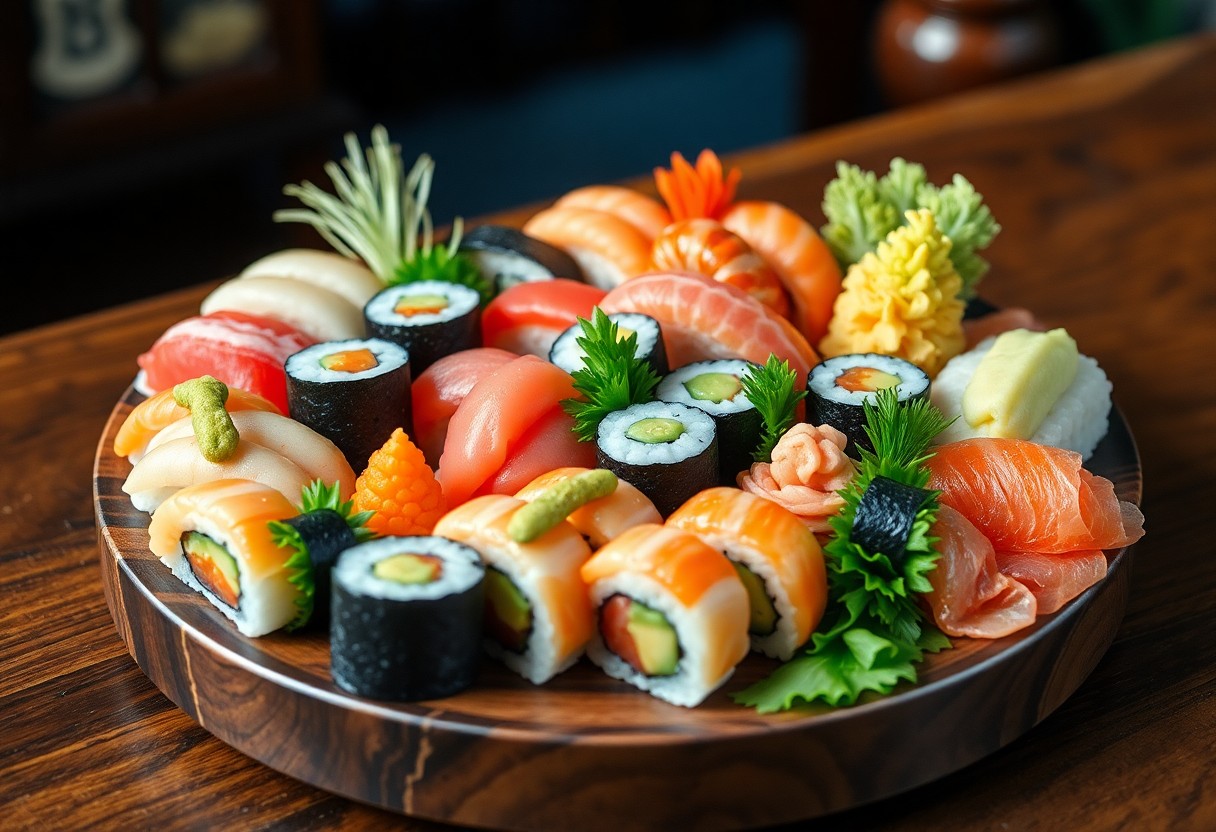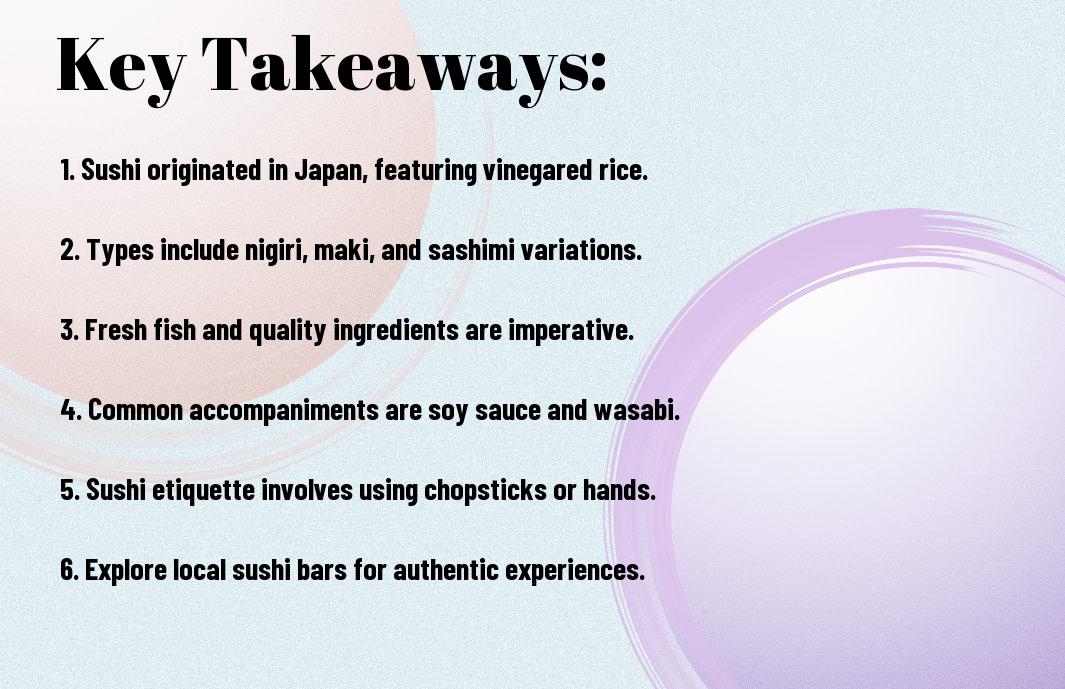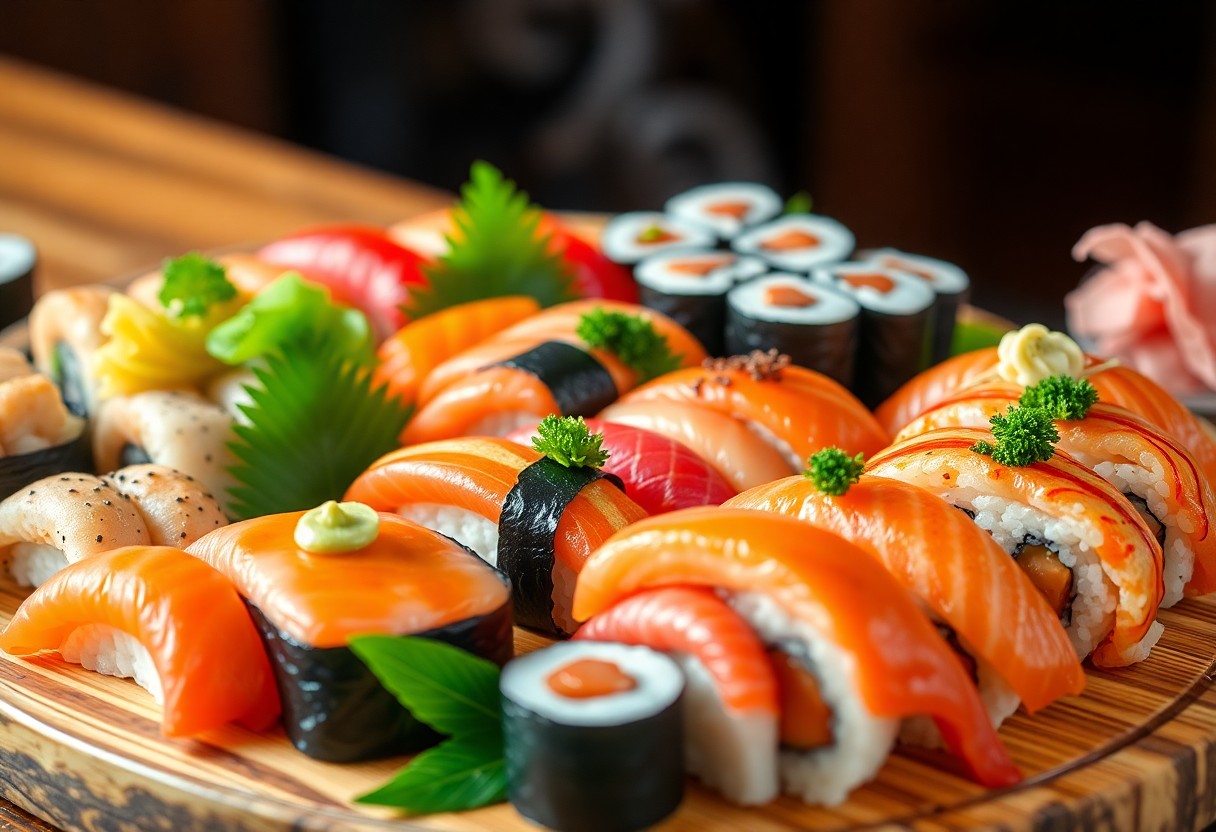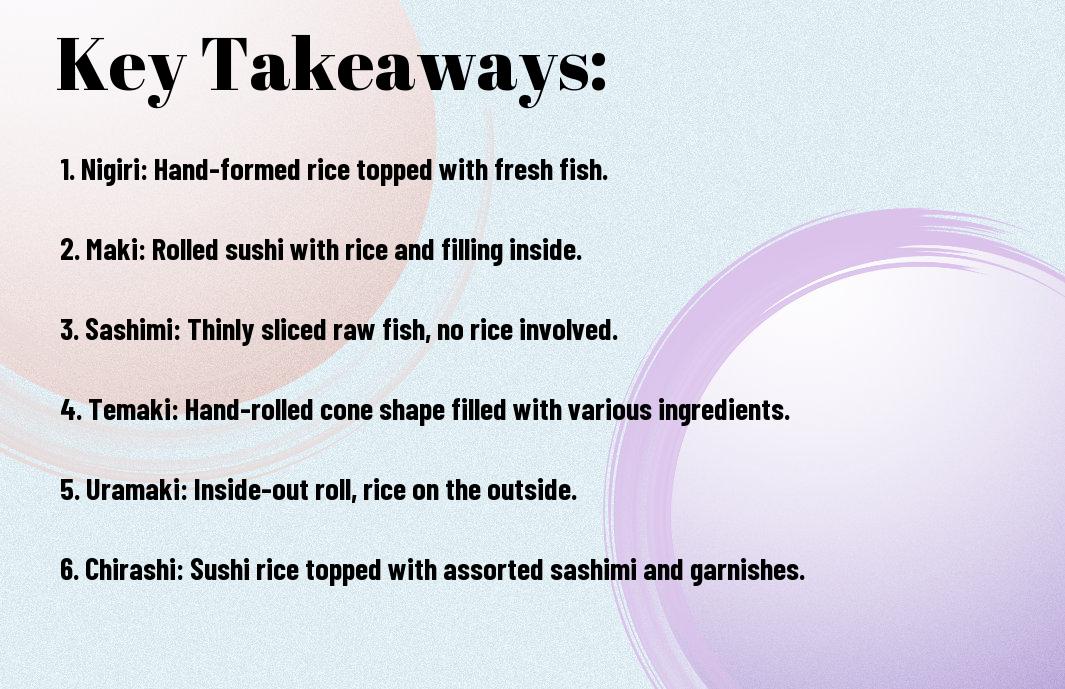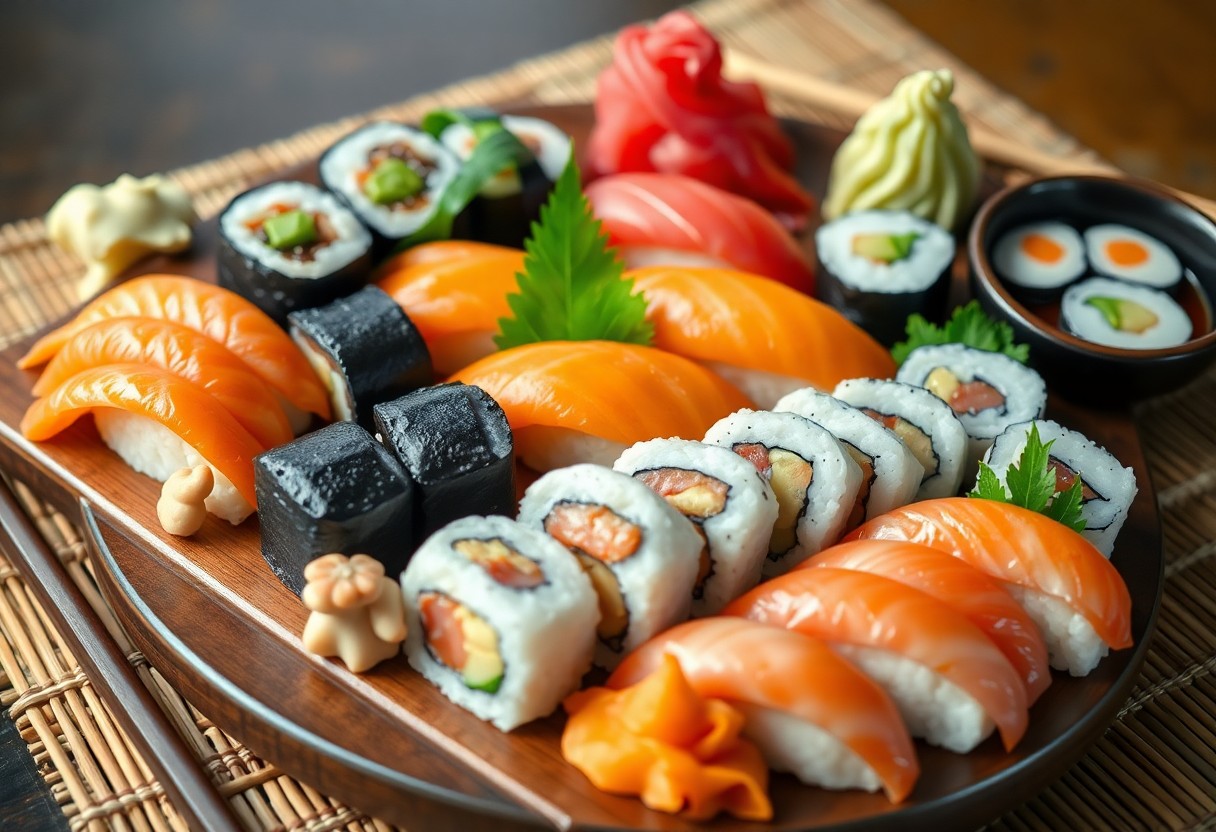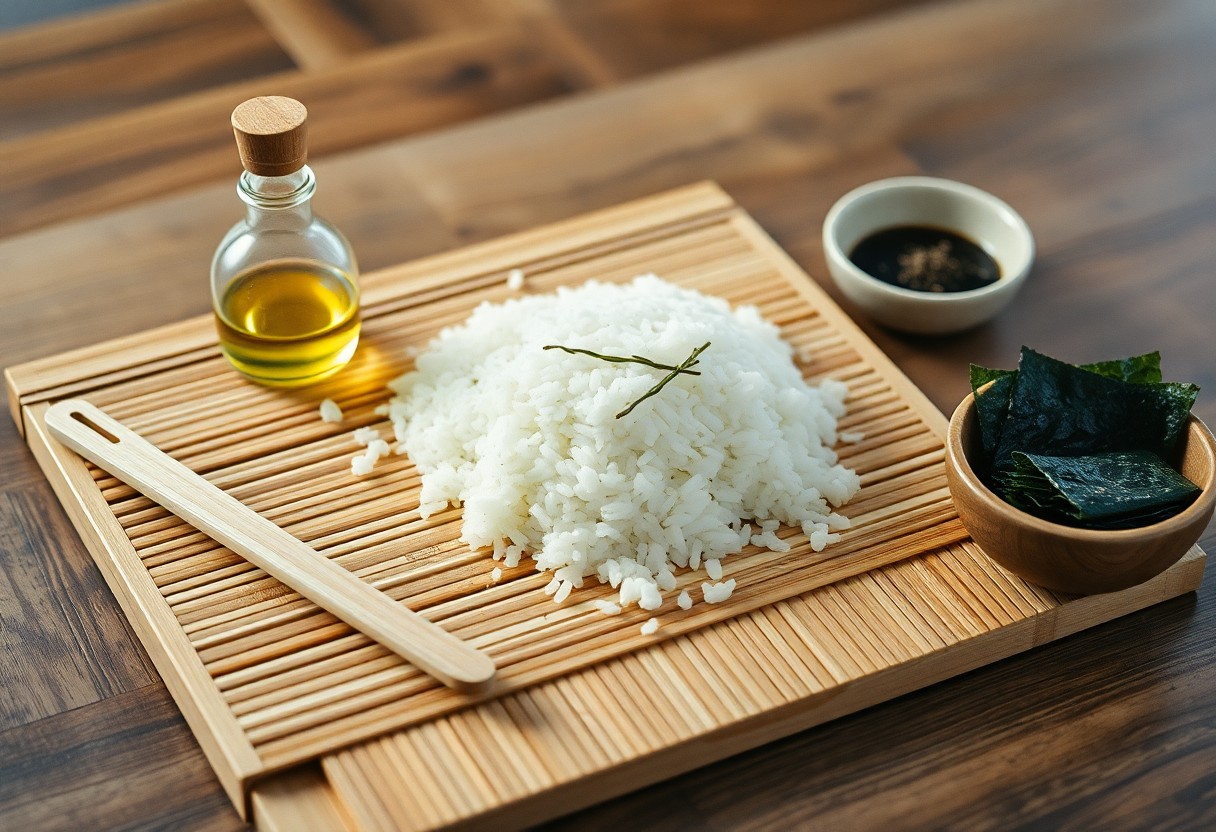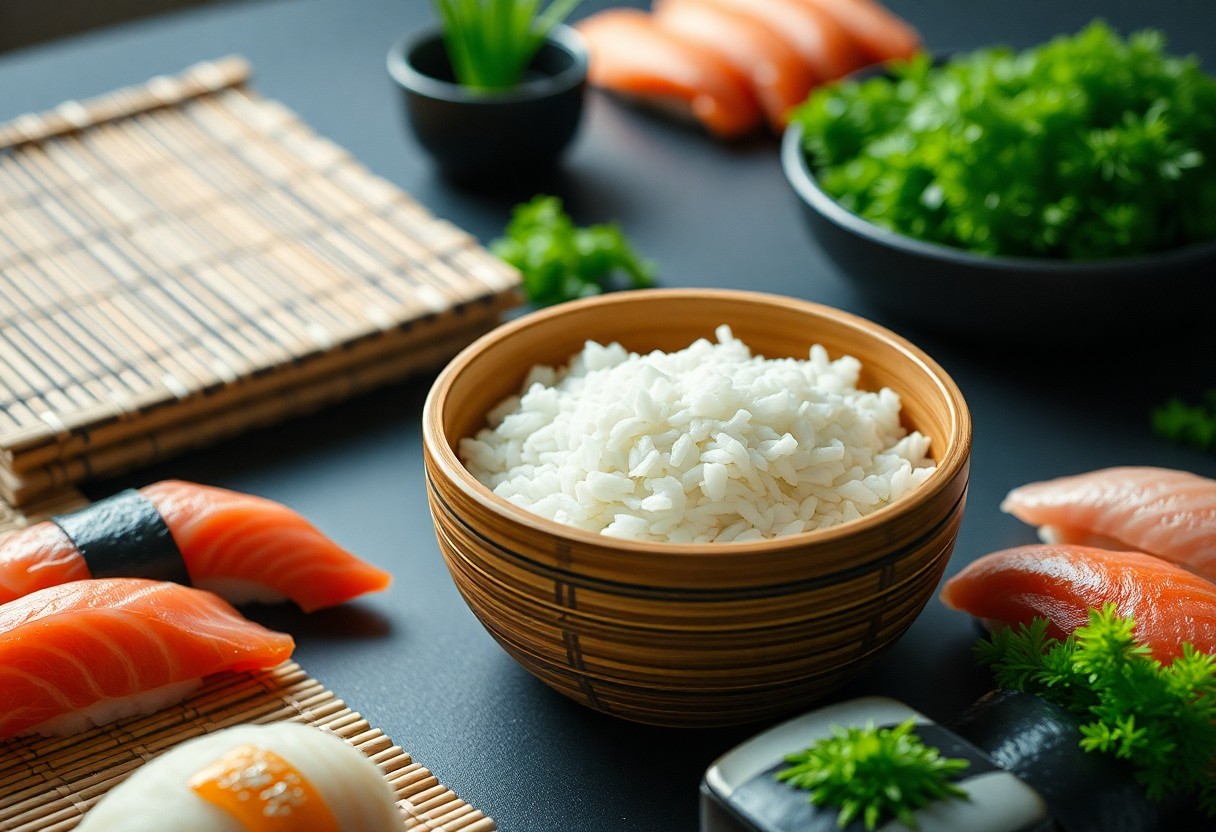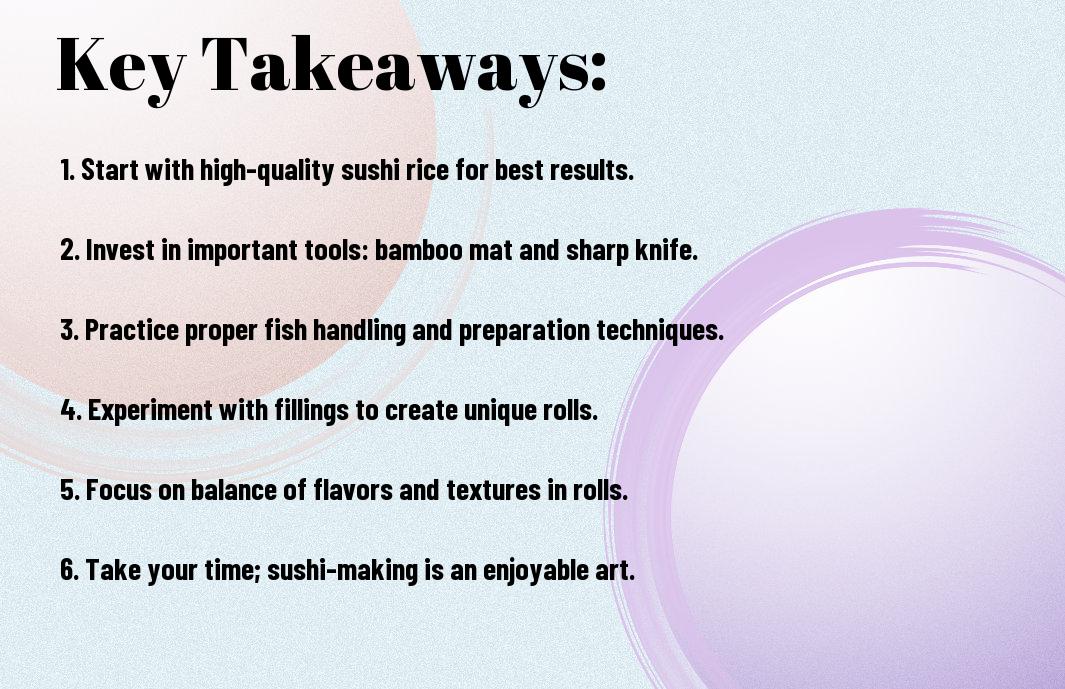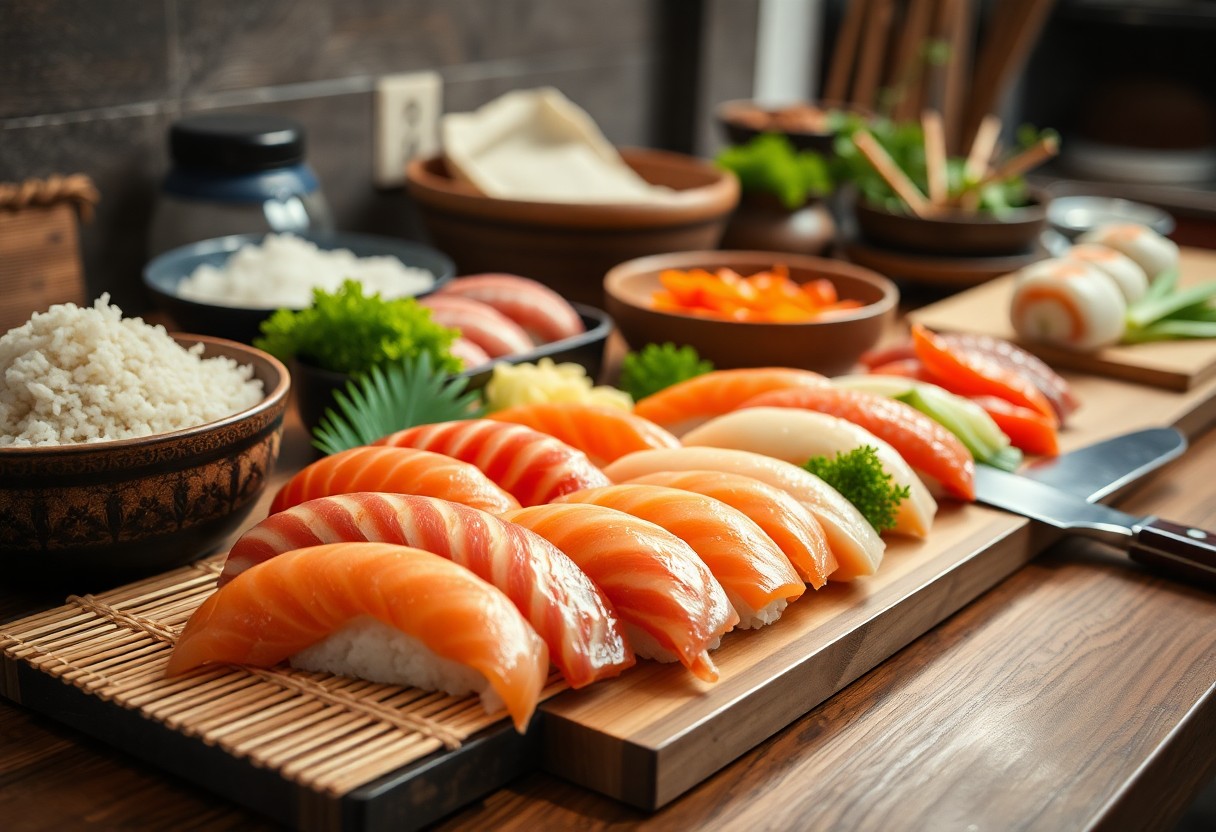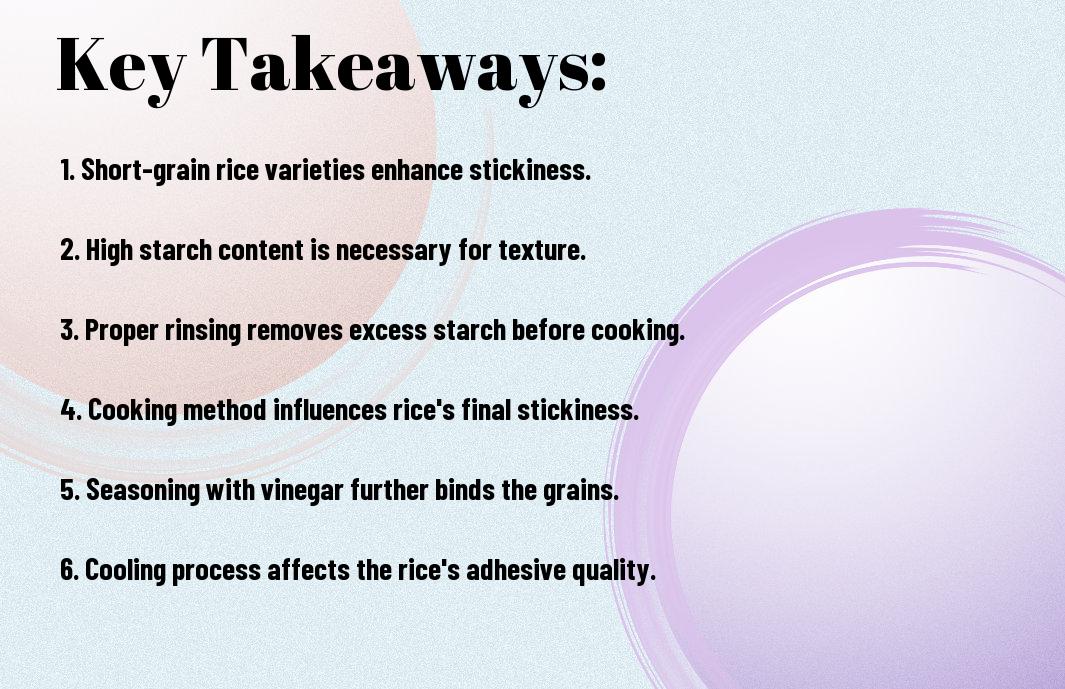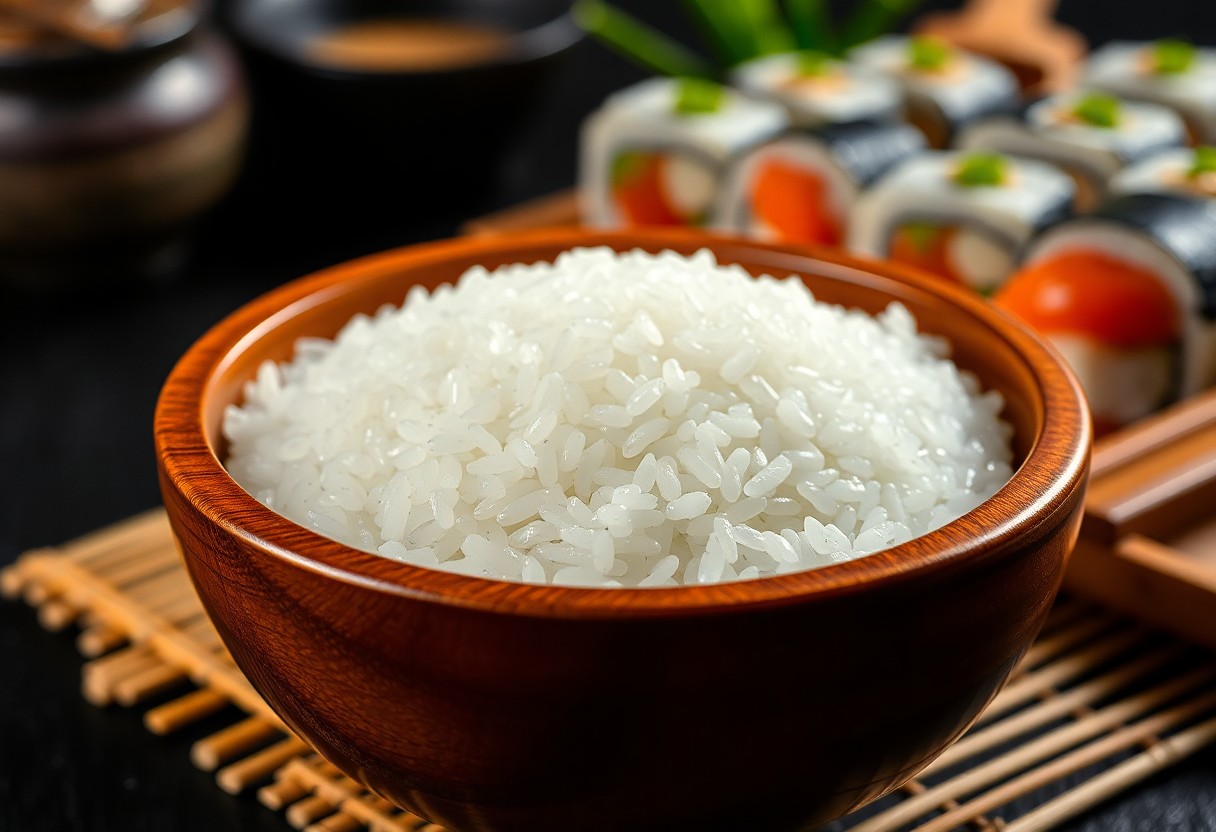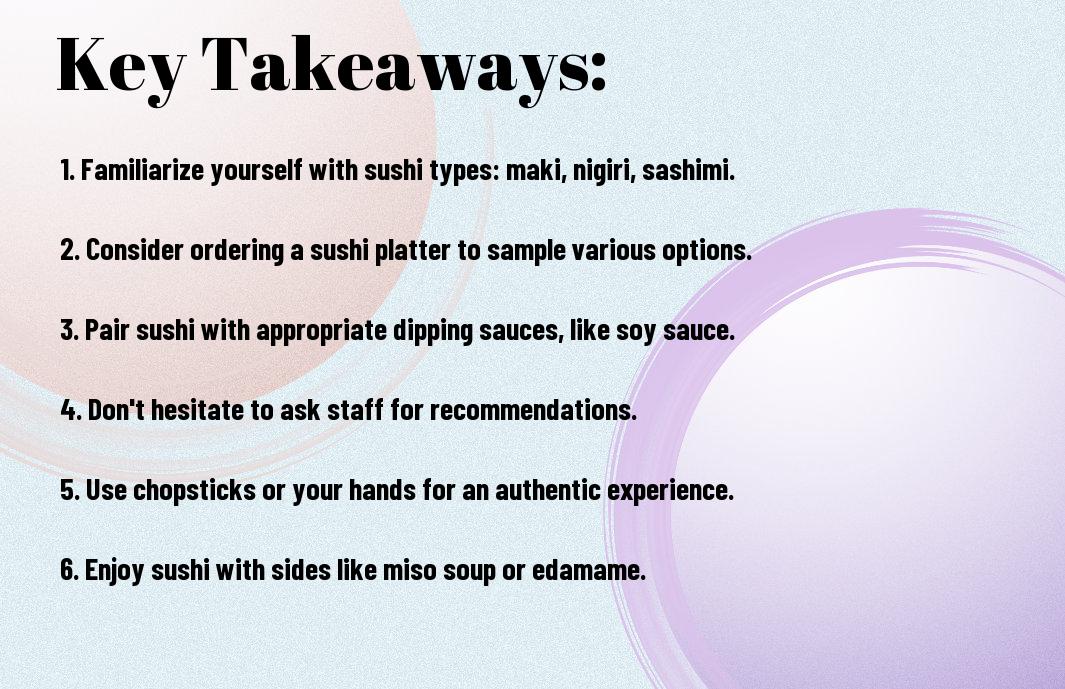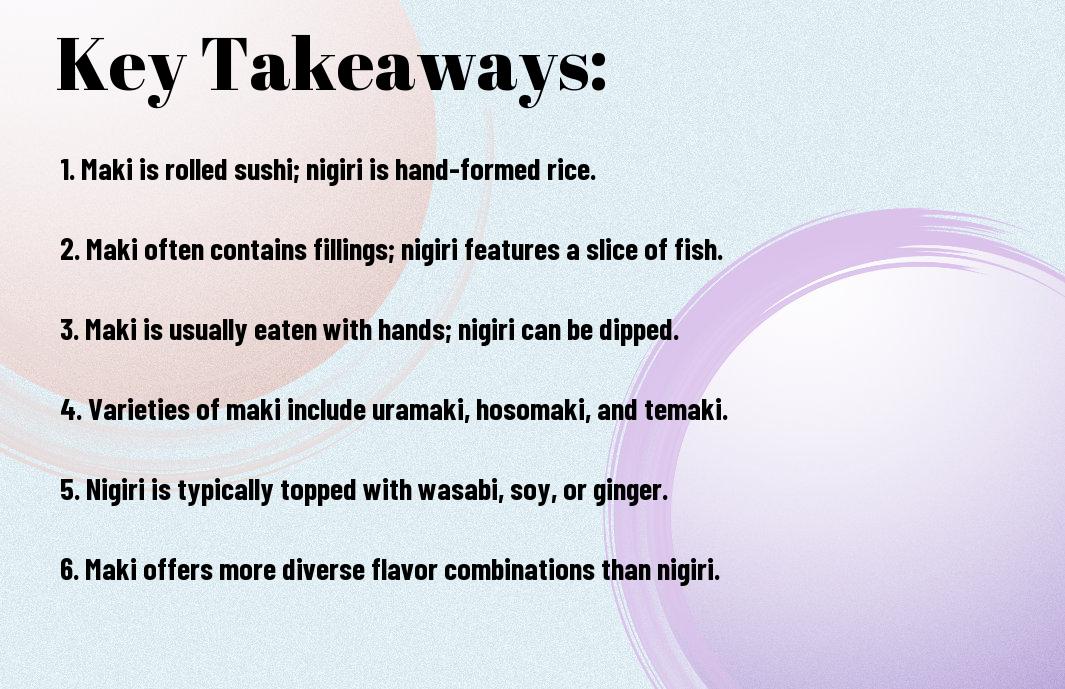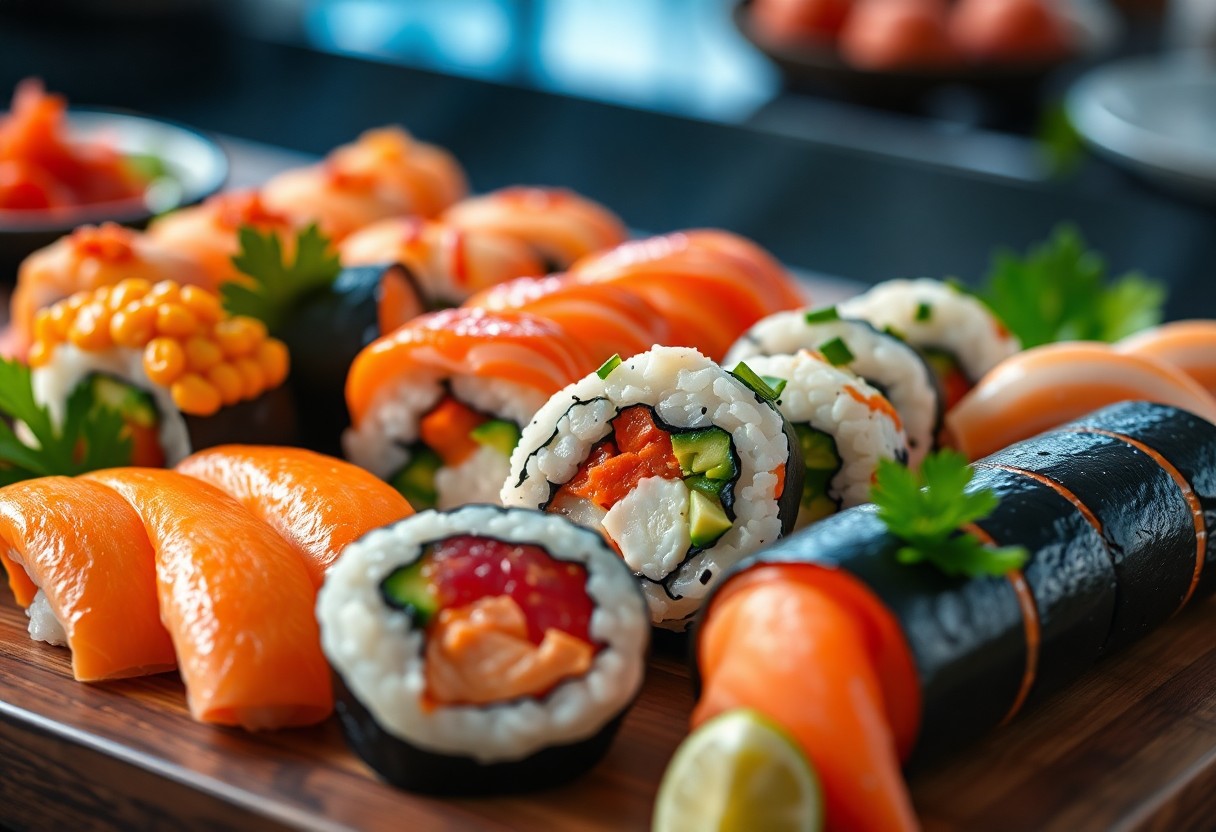Many sushi enthusiasts find joy in exploring the diverse world of sushi, and now it’s your turn to dive in! This guide will unravel everything you need to know to enhance your sushi experience—from the different types available to tips on how to properly eat it and important food safety practices. You can also check out Sushi 101: Different Types, How to Eat It, and Food Safety for a more comprehensive understanding. Get ready to begin on your sushi journey!
Key Takeaways:
- Sushi Types: Learn about the various types of sushi, including nigiri, maki, and sashimi, each with unique ingredients and presentation styles.
- Essential Ingredients: Familiarize yourself with key sushi components such as sushi rice, vinegar, seaweed, and fresh fish, which form the foundation of sushi making.
- Preparation Techniques: Understand the different techniques used in sushi preparation, including rice cooking, fish slicing, and rolling, to create authentic dishes.
- Sushi Etiquette: Explore proper sushi dining etiquette, covering aspects like chopstick usage, soy sauce dipping, and when to use ginger.
- Health Considerations: Acknowledge the nutritional benefits of sushi, while also being aware of potential health risks associated with consuming raw fish.
The History of Sushi
The history of sushi is a fascinating journey that spans centuries, reflecting Japan’s rich culinary heritage. Originating as a method of preserving fish in fermented rice, sushi has transformed over time into the flavorful delicacy you enjoy today. This evolution has been influenced by regional ingredients, cultural exchanges, and innovations in cooking styles, making sushi not just a dish, but a significant part of Japan’s identity and cuisine.
Origins of Sushi
Origins of sushi can be traced back to Southeast Asia, where fish was preserved using fermented rice. This method eventually made its way to Japan, where it evolved into a more distinctive form. Early sushi, known as narezushi, featured fish fermented with rice for months and was primarily consumed out of necessity rather than flavor. This early practice laid the groundwork for what you now recognize as sushi.
Evolution of Sushi Styles
Styles of sushi have evolved dramatically over the years, influenced by social trends and culinary advancements. As you explore the various sushi styles, you’ll find distinct forms, including nigiri, maki, and sashimi, each catering to different tastes and occasions. These styles reflect not just regional ingredients but also the innovative spirit of Japanese chefs who continuously adapt sushi to suit modern palettes.
In addition to the well-known forms, each sushi style showcases unique preparation techniques and flavor profiles. For instance, nigiri presents a hand-formed rice base topped with fresh fish, allowing the flavors to shine in their simplicity. Maki rolls introduce a variety of ingredients wrapped in rice and seaweed, making them visually appealing and diverse. The evolution of sushi continues to inspire chefs worldwide, leading to creative interpretations and fusion cuisines that reflect your ever-changing tastes.
Types of Sushi
Some of the most popular types of sushi include a delightful variety that caters to different tastes and preferences. Understanding these various styles can enhance your sushi experience. Here’s a breakdown of the main types:
| Nigiri | Hand-formed rice with a topping |
| Maki | Rolled sushi with rice and filling |
| Sashimi | Thinly sliced raw fish |
| Temaki | Hand-rolled cone of seaweed and fillings |
| Uramaki | Inside-out roll with rice on the outside |
After exploring these types of sushi, you can appreciate the diverse selections available.
Nigiri
Against popular belief, nigiri is more than just a piece of rice with fish. It consists of a small mound of sushi rice topped with a slice of raw fish, often accompanied by wasabi and soy sauce. This straightforward yet elegant presentation allows the natural flavors of the rice and fish to shine.
Maki
Between various sushi styles, maki stands out due to its rolled nature. Maki sushi is crafted by rolling vinegared rice and various fillings, wrapped in seaweed (nori). This offers a balanced combination of flavors and textures.
Nigiri is versatile, with numerous filling options, from fresh fish to vegetables. You can easily adapt the ingredients to your preferences, making it a perfect canvas for culinary creativity.
Sashimi
Sushi is often associated with sashimi, but they are different dishes. While sushi includes rice, sashimi refers strictly to thin slices of raw fish or seafood, served without any rice. This allows you to savor the purity of the ingredients.
This distinction is vital for a well-rounded sushi experience, highlighting the quality of the fish alone, often adorned with minimal garnishes like wasabi or pickled ginger to complement its natural taste.
Temaki
One of the more interactive types of sushi, temaki, is a hand-rolled cone made of nori filled with sushi rice, fish, and various ingredients. It offers a fun and casual way to enjoy sushi, allowing you to customize your roll with the fillings of your choice.
Consequently, temaki is not only delicious but also encourages creativity; you can explore endless combinations, making it a favorite for sushi enthusiasts. Enjoying that hands-on experience can elevate your sushi evenings with friends or family.
Sushi Ingredients
Now that you’re intrigued by sushi, it’s crucial to understand the key ingredients that make this dish so delightful. Sushi isn’t just about raw fish; it comprises various components, including rice, seafood, vegetables, and seasonings, each contributing to the overall flavor and experience. By familiarizing yourself with these ingredients, you’ll appreciate the art of sushi-making even more and can effectively explore various sushi types.
Rice
With sushi rice being the foundation of any great sushi roll, its preparation is vital. Unlike regular rice, sushi rice is short-grain and sticky, allowing it to hold together when formed into various shapes. You also need to season it with a mixture of rice vinegar, sugar, and salt for that signature sushi taste.
Fish and Seafood
Along with rice, fresh fish and seafood are perhaps the most recognized sushi ingredients. The key to great sushi is sourcing high-quality, fresh ingredients, which will significantly impact the flavor and texture of your dish. Popular choices include tuna, salmon, and shrimp, each bringing unique tastes and textures.
In fact, different fish options can elevate your sushi experience. Tuna can be served as sashimi or nigiri, while salmon can complement various rolls. Additionally, you might find treasures like mackerel, eel, or even octopus in your sushi, all contributing to the skillful balance of flavors and showcasing the freshness that defines this dish.
Vegetables and Other Fillings
With vegetables and other fillings, sushi is not just about fish. Fresh and colorful vegetables like cucumber, avocado, and carrots not only add flavor but also bring nutritional value and visual appeal to your sushi. You can also experiment with various fillings for different tastes and textures.
Rice toppings like pickled daikon or spicy mayo can amplify the flavors of your sushi rolls. Furthermore, many sushi lovers enjoy combinations such as avocado and cucumber for a light and refreshing bite. You can even venture into vegetarian sushi and create delightful rolls solely focused on the vibrant bounty of the produce available to you.
How to Make Sushi at Home
Your journey to creating delicious sushi at home starts with understanding the basics. By following this guide, you can master the art of sushi-making with practice and patience. For further insights, check out Sushi 101: An Expert’s Guide to the World of Sushi to enhance your skills and appreciation for this culinary art.
Essential Tools and Equipment
After gathering your ingredients, you’ll need some imperative tools to make sushi effortlessly. A sharp knife for cutting, a bamboo mat for rolling, and a rice cooker can significantly ease the process. Additionally, sushi-grade fish, nori, and sushi rice are non-negotiable items for your sushi toolkit.
Step-by-Step Guide
Against the backdrop of traditional sushi-making techniques, follow this structured approach to create your homemade rolls:
| 1. Prepare sushi rice | Cook and season sushi rice with vinegar, sugar, and salt. |
| 2. Slice ingredients | Thinly slice your choice of fish and vegetables. |
| 3. Assemble your roll | Lay nori on the bamboo mat, add rice, fish, and veggies. |
| 4. Roll it up | Use the bamboo mat to roll tightly, applying even pressure. |
| 5. Cut and serve | Slice your roll into bite-sized pieces and enjoy. |
But the real key to success lies in your execution of each step. Pay attention to the balance of flavors and textures as you roll your sushi. Challenge yourself with different fillings, such as avocado or tempura shrimp. The more you practice, the more you’ll discover the delightful variations you can create!
| Keep your hands wet | This prevents rice from sticking to your fingers while rolling. |
| Use sushi-grade fish | Always use high-quality fish to ensure safety and flavor. |
| Experiment | Don’t hesitate to try different ingredients and flavors! |
Sushi Etiquette
Despite the casual nature of sushi dining, understanding etiquette can elevate your experience. You should always greet your sushi chef and respect the environment by keeping your voices low. It’s also important to place your order politely, as it shows appreciation for the skill involved in crafting each piece. Adhering to these traditions transforms a simple meal into a cultural experience.
Dining Traditions
Sushi is more than just food; it’s a tradition steeped in respect and ritual. When you enter a sushi restaurant, you often bow slightly and say “irasshaimase” (welcome). Once seated, you may notice the chef preparing your meal, which is an art form in itself. Enjoying each piece as it’s served allows you to experience the true essence of sushi dining.
Proper and Improper Practices
For an authentic sushi experience, it’s imperative to follow proper and avoid improper practices. This includes not mixing wasabi directly into your soy sauce and instead placing a small amount of wasabi atop each piece before dipping it lightly in the sauce. Additionally, using your fingers to eat sushi is acceptable, particularly with nigiri, unless you prefer chopsticks.
To truly enjoy sushi, you should familiarize yourself with proper dipping techniques, which involve minimizing the sushi’s contact with the soy sauce. Always dip the fish side, not the rice, into the sauce to prevent the rice from absorbing too much liquid. As far as sushi rolls, using your fingers is fine, but chopsticks are perfectly acceptable if you prefer them. Lastly, avoid overwhelming your palate with too many flavors at once; savor each piece to appreciate its unique taste.
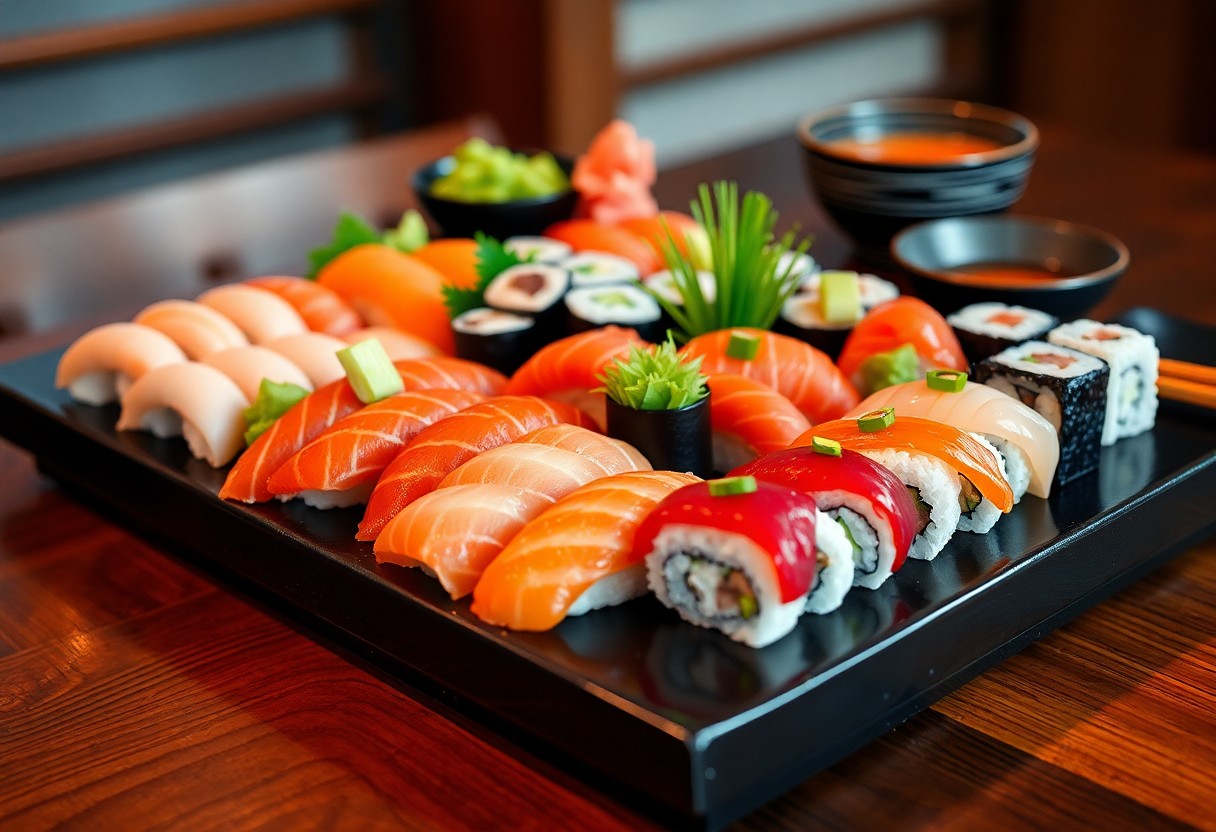
Where to Enjoy Sushi
All sushi enthusiasts will agree that finding the perfect spot to enjoy sushi enhances the overall experience. Whether you prefer a casual vibe or an upscale dining atmosphere, there are various options to satisfy your sushi cravings. From intimate sushi bars specializing in the art of omakase to bustling restaurants offering diverse menus, the choices are plentiful. Your location and mood will dictate where to begin on your sushi journey.
Sushi Bars vs. Restaurants
Restaurants that serve sushi can vary drastically in style and quality. Sushi bars often focus solely on sushi and sashimi, allowing you to interact directly with skilled chefs who provide a personalized experience. In contrast, full-service restaurants may offer a broader range of Japanese cuisine, but the sushi quality may not always match that of a dedicated sushi bar. Your preference will guide your choice.
Tips for Choosing a Quality Sushi Spot
Around you, numerous sushi establishments vie for your attention, but selecting a quality sushi spot is crucial for a delicious experience. Pay attention to the following factors:
- Freshness of ingredients
- Hygiene and cleanliness
- Quality of fish and rice
- Chef’s expertise and experience
Any of these indicators can help you ensure you’re in for an enjoyable meal.
Plus, considering the ambiance and customer service can enhance your dining experience. Choosing a place that makes you feel welcomed and comfortable is vital. When selecting your sushi destination, also take note of the following:
- Customer reviews and ratings
- A wide variety of menu options
- Traditional techniques or innovative twists
- Availability of seasonal specials
Any combination of these factors will lead you to a fantastic sushi experience.
To wrap up
Now that you’ve explored the imperatives of sushi, you have the foundational knowledge to appreciate this culinary art form fully. From understanding different types of sushi to learning how to enjoy it properly, your experience can elevate significantly. Whether you’re ordering at a restaurant or trying your hand at making sushi at home, this guide equips you with the insight to enhance your journey into the world of sushi, ensuring that each bite is as enjoyable as it is authentic.
Q: What are the main types of sushi, and how do they differ?
A: There are several primary types of sushi, each varying in preparation and presentation. The most common include:
- Nigiri: A hand-formed mound of rice topped with a slice of fish or seafood.
- Maki: Sushi rolls made with rice and fillings, wrapped in seaweed (nori) and sliced into bite-sized pieces.
- Sashimi: Sliced raw fish served without rice, often accompanied by soy sauce and wasabi.
- Temaki: Hand-rolled sushi that resembles a cone, filled with rice and various ingredients.
- Uramaki: An inside-out roll where the rice is on the outside of the nori, often topped with additional ingredients.
Each type of sushi offers a unique way to enjoy the flavors and textures of fresh ingredients.
Q: What are important ingredients used in sushi?
A: The key ingredients in sushi typically include:
- Sushi Rice: Short-grain rice seasoned with vinegar, sugar, and salt, providing the base for many sushi types.
- Nori: Dried seaweed sheets used to wrap various sushi varieties, particularly maki and temaki.
- Fresh Fish and Seafood: Sushi often features high-quality fish like tuna, salmon, and eel, as well as shellfish like shrimp and crab.
- Vegetables: Common fillings and toppings include cucumber, avocado, and pickled radish.
- Condiments: Soy sauce, wasabi, and pickled ginger enhance the flavor profile and complement the fresh ingredients.
These ingredients not only define sushi’s flavor but also its cultural significance.
Q: How should sushi be properly enjoyed and served?
A: Sushi is best enjoyed using specific techniques to enhance the experience:
- Serving Temperature: Sushi should be served at room temperature to appreciate the flavors and textures fully.
- Using the Right Utensils: Sushi can be eaten with chopsticks or with your hands. Nigiri is often enjoyed with fingers, while maki is suitable for chopsticks.
- Condiments: Dip the fish side of nigiri into soy sauce, avoiding the rice to prevent it from becoming soggy. Use wasabi as desired, but keep in mind some sushi may already be seasoned with it.
- Order and Taste: Start with lighter-flavored fish and gradually move to richer options. For a true gastronomic experience, savor each piece before moving on to the next.
Proper enjoyment not only enhances taste but also pays homage to the artistry behind sushi-making.
